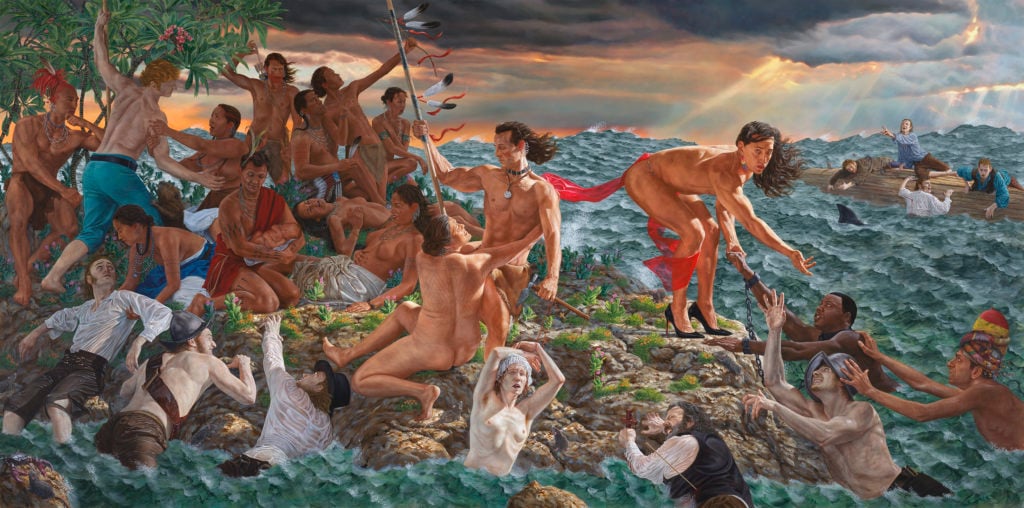When visitors enter the Great Hall of New York’s Metropolitan Museum of Art this month, they will be greeted with something unusual: a pair of monumental history paintings by Cree artist Kent Monkman. The massive canvases—almost 11 feet by 22 feet—seek to do nothing less than turn conventional Western art history on its head.
The exhibition, titled “mistikosiwak (Wooden Boat People),” comprises two massive paintings, Welcoming the Newcomers and Resurgence of the People. The show’s title—which comes from the Cree name for European settlers arriving at what is now known as North America—offers a fitting introduction to Monkman’s MO: to provide a view of history and art that centers those who have long been viewed as “other.” Both paintings star Monkman’s gender-fluid alter ego, Miss Chief Eagle Testickle, a representation of indigenous Two Spirit traditions.
The artist, who is 54 and from Canada, was commissioned to create the two works as part of director Max Hollein’s new series of contemporary “activations” responding to the Met collection, which to date have included an immersive video installation from Ragnar Kjartansson and the first-ever exhibition on the building’s facade, by Wangechi Mutu.
Monkman was surprised to get the call from the museum—“I didn’t even know that I was on their radar,” the artist admitted to Artnet News—but eager to create work inspired by the Met’s holdings, which he was familiar with thanks to visiting regularly over the past 25 years. On a walk through the Met’s galleries with Artnet News, he pointed out various works that inspired his own. But while the works in the Met’s collection tend to present an image of Native people as shrinking and doomed, while picturing North America itself as a vast wilderness ripe for the taking, Monkman offers an alternative story.
“I could pinpoint specific works in the Met’s collection and say, ‘Here we have this theme that keeps recurring over and over again in the 19th century which reinforces this idea of extinction,’” Monkman explained. “That was a very useful theme in that period of time, because the settlers wanted our lands, they wanted us gone.”
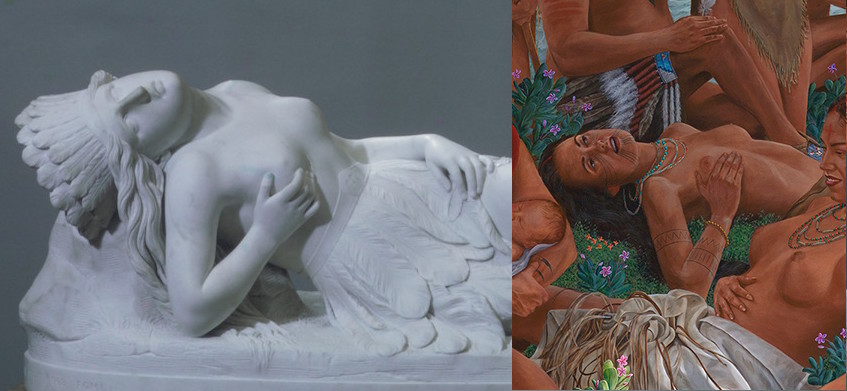
Thomas Crawford, Mexican Girl Dying (1846–48) and the figure inspired by the sculpture in Kent Monkman’s Welcoming the Newcomers (2019). Photo courtesy of the Metropolitan Museum of Art.
An Alternative History
“To me, there’s a way to breathe life into these themes of extinction and refute that erasure,” the artist said. Taking me to the Met’s sunlit Engelhard Court, he pointed to Thomas Crawford’s Mexican Girl Dying (1846), a dramatic sculpture of a fallen young woman clutching a wound under her right breast. It was the inspiration for one of the figures in his new work—but Monkman chose to translate her pain into pleasure. “When I saw that beautiful marble sculpture, I was taken with how sensual and erotic that image is,” he said. “In my painting, she’s ostensibly having an orgasm.”
The Met has plenty of examples of Native figures being either brutalized or romanticized. Monkman calls attention to Augustus Saint-Gaudens’s Hiawatha (1871–72, carved 1874), just a few feet away from Mexican Girl Dying. “He looks like this Greek god in the way that his body has been idealized,” he said. “I see of a fantasy of an indigenous person.”
The work also calls attention to how often indigenous stories are told by outsiders. “It’s a sculpture made by a settler artist about a poem written by another non-indigenous person, so there are levels of removal, taking it further and further away from real indigenous people,” he said.
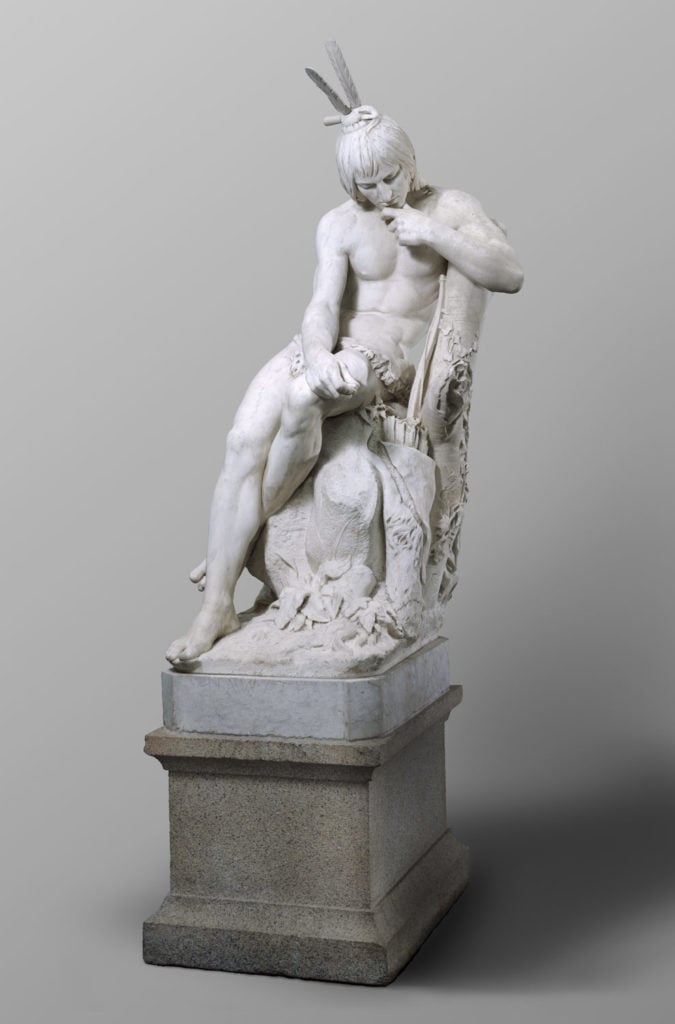
Augustus Saint-Gaudens, Hiawatha (1871–72, carved 1874). Photo courtesy of the Metropolitan Museum of Art.
To address this issue at an institution as important as the Met is a big moment for Monkman. “Museums have been culpable in reinforcing this disappearance, often segregating the indigenous art and artifacts to their own wings which cuts them off from the continuum of our living and vibrant contemporary cultural expressions,” he said.
The Met has had its own history with this issue. The museum announced it would hire its first full-time curator of indigenous art for its American wing in September. But nearly a year earlier, it was subject to criticism from a Native American advocacy group, which claimed it was not appropriate for the museum to display Native works as art in its American wing.
At the press preview, Hollein acknowledged that institutions are making up for lost time. Monkman’s work, he said, “fosters and surfaces an important part of American history, maybe a history and a story that has been suppressed for some time and that we have not properly reflected on here at the museum.” Sheena Wagstaff, the museum’s chairman of Modern and contemporary art, went further, declaring that “museums can no longer maintain a position of neutrality.”
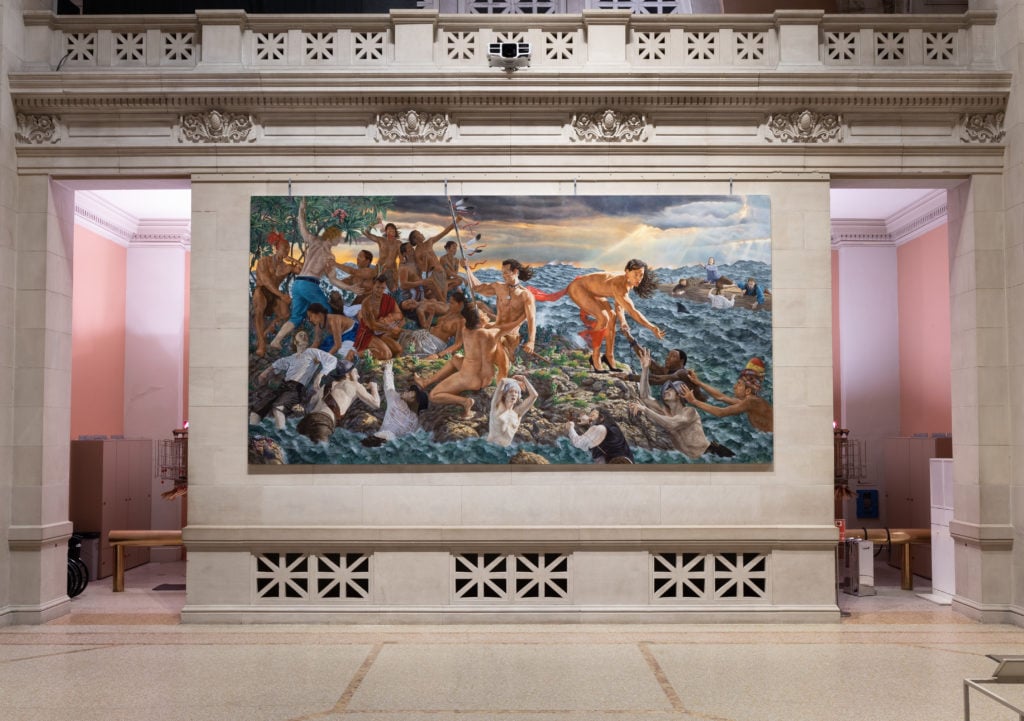
Intallation view of Kent Monkman’s Resurgence of the People (2019). Photo by Anna Marie Kellen, courtesy of the Metropolitan Museum of Art.
A Monumental Undertaking
Monkman’s paintings offer both a revision of the past and a look into the future. Where Welcoming the Newcomers shows Miss Chief Eagle Testickle reaching out to help various stranded figures being washed ashore (a counter-narrative to the typical picture of violent tribes attacking European settlers), the indigenous people are the ones set adrift in Resurgence of the People, with armed white nationalists laying claim to the only visible land.
“I took inspiration from those heartbreaking photographs of migrants on these too small boats, hundreds of people crammed in headed for some place better,” said Monkman. “This painting is kind of set in the future. Rising sea levels will impact millions of people around the world, so I wanted to think about migrating populations will affect us all in the future.”
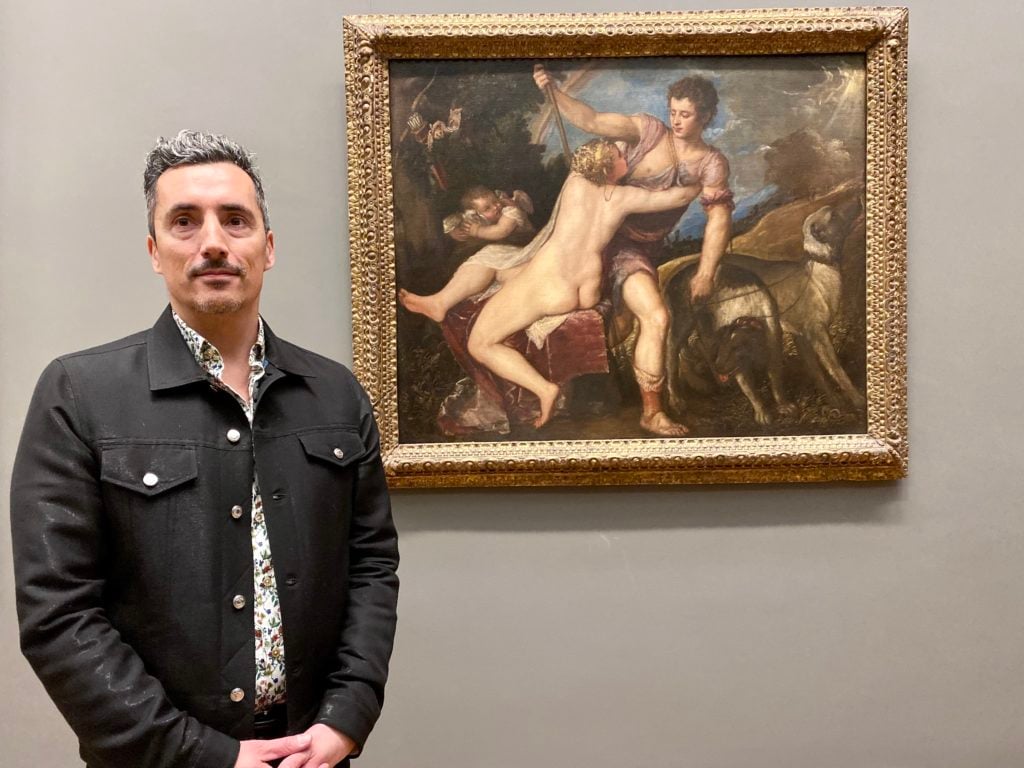
Kent Monkman with Titian’s Venus and Adonis (1550s) at the Metropolitan Museum of Art. Photo by Sarah Cascone.
A maritime painting in the Met’s collection is perhaps the most prominent reference in Resurgence of the People: Emanuel Leutze’s famed Washington Crossing the Delaware (1851). “You come into this museum and you see this massive history painting that really celebrates Washington, who was a slave owner and committed atrocities against indigenous people,” said Monkman. “I wanted to create a painting that equaled the scale of that painting rivaled it in size.”
Nearly 11 feet by 22 feet, the paintings brushed against the ceiling rafters of Monkman’s studio, where he worked with a team of 10 painters to complete the ambitious works. Each one began with a sketch, before Monkman brought in models—and a real wooden boat—to pose for the dynamic scenes.
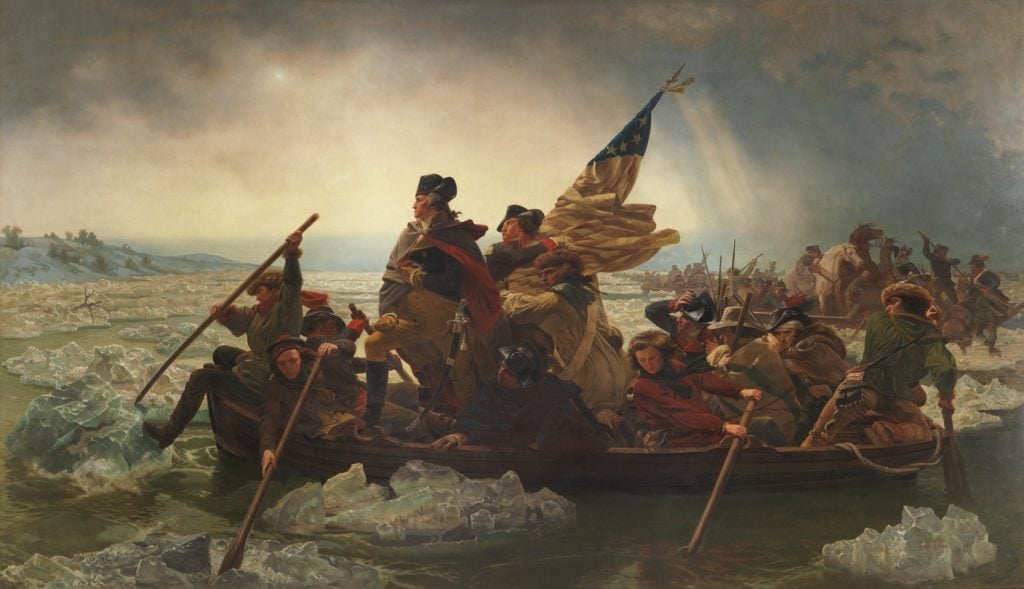
Emanuel Leutze, Washington Crossing the Delaware (1851). Courtesy of the The Metropolitan Museum of Art, gift of John Stewart Kennedy, 1897.
The artist turned to the Old Masters for inspiration when he realized that the visual language of abstract painting was too limited to address the themes that interested him. “All artists throughout history learn from each other,” Monkman pointed out as we moved to the European paintings wing, where a pair of Venus and Adonis paintings, one by Titian, the other by Peter Paul Rubens, hang in nearby galleries, the Italian artist clearly having influenced the later painter.
“I wanted to riff on that idea of artists looking back and taking inspiration from these traditions of painting and how that can be reinterpreted over and over again in different ways,” Monkman added. “I feel like I’m an outsider looking at this trajectory of Western art going, ‘Wow, you had this great tradition of painting, and you guys kind of discarded it.’”
Both Venus and Adonis compositions are referenced in “mistikosiwak,” one with an indigenous couple, the other with a male settler and an indigenous woman. The original myth, in which Venus attempts to seduce Adonis, who would rather be off hunting, resonated with Monkman. “When I thought about the history of the continent,” he explained, “so much was driven by the fur trade and the trapping of animals. The Europeans were here to basically extract recourses.” He’s represented that by replacing the small angel in the Rubens painting with a beaver, which he describes as “the first currency of this continent.”
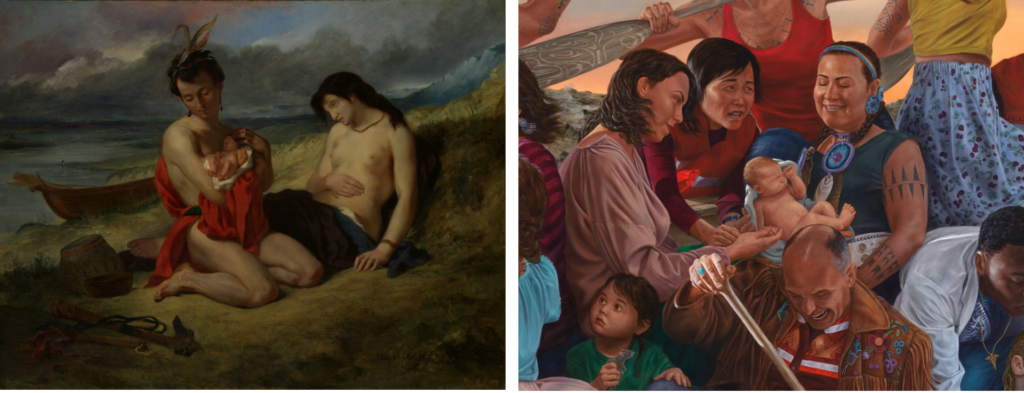
A detail from Eugène Delacroix’s The Natchez (1823–24 and 1835) inspired this detail of Kent Monkman’s Resurgence of the People (2019). Courtesy of the Metropolitan Museum of Art.
The compositions also mirror one another in the repetition of figures drawn from Eugène Delacroix’s The Natchez (1823–24 and 1835), of an indigenous couple giving birth on the roadside while fleeing French soldiers. Amid the chaos of both of Monkman’s paintings, the two birth scenes—one featuring a same-sex couple—represent “the celebration of life and the continuum of our culture,” the artist said.
Monkman is excited for visitors to the Met to encounter this work, prominently displayed in the recently revamped Great Hall. (The ticket booths were removed in October, and moved inside the smaller lobby gift shop, creating a more open space.)
“I want people to be surprised that these are the works of an indigenous artist. I think a lot of people’s perceptions of who an indigenous artist is or the kind of work that an indigenous artist make are probably very different from what you see here. But we’ve been in contact with European artists for 500 years,” Monkman said. “There’s a long history of exchange back and forth.”
“Kent Monkman: mistikosiwak (Wooden Boat People)” is on view at the Metropolitan Museum of Art, 1000 Fifth Avenue, December 19, 2019–April 9, 2020.
